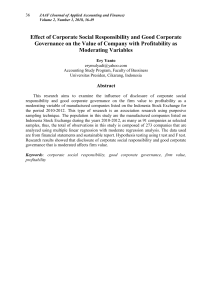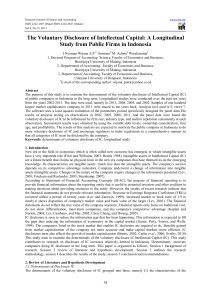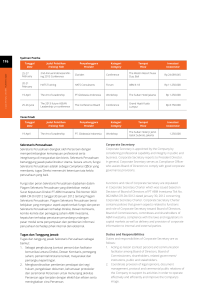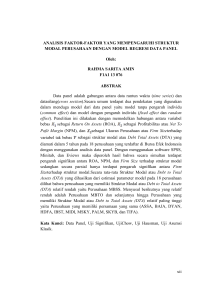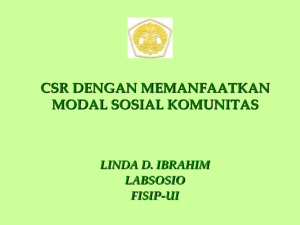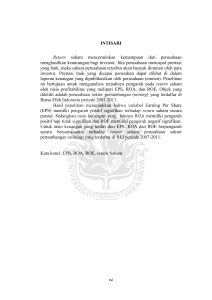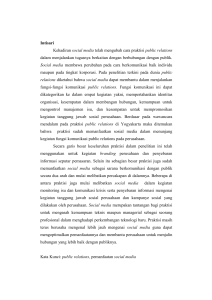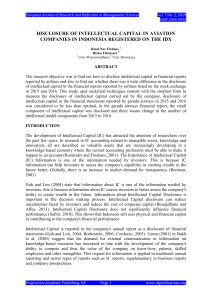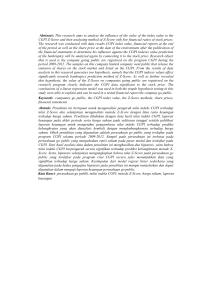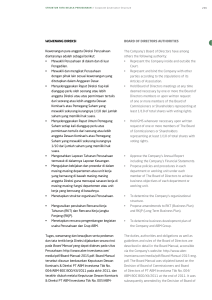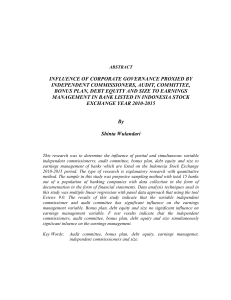FULL PAPER ICCB BALI Dian Indriana
advertisement
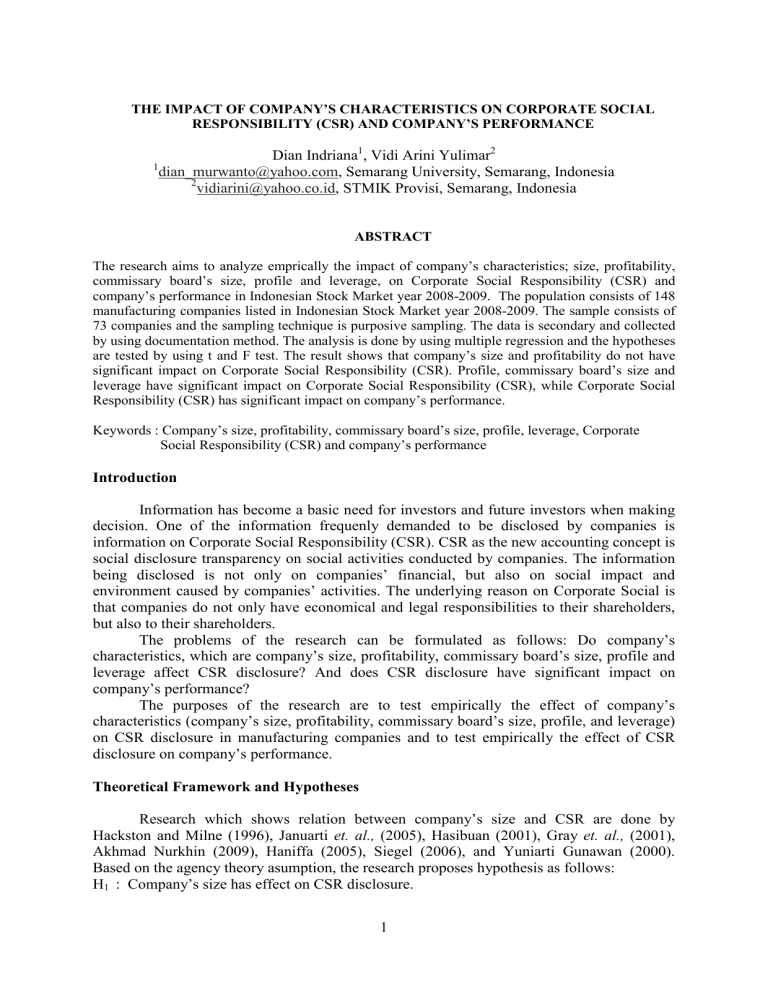
THE IMPACT OF COMPANY’S CHARACTERISTICS ON CORPORATE SOCIAL RESPONSIBILITY (CSR) AND COMPANY’S PERFORMANCE Dian Indriana1, Vidi Arini Yulimar2 1 [email protected], Semarang University, Semarang, Indonesia 2 [email protected], STMIK Provisi, Semarang, Indonesia ABSTRACT The research aims to analyze emprically the impact of company’s characteristics; size, profitability, commissary board’s size, profile and leverage, on Corporate Social Responsibility (CSR) and company’s performance in Indonesian Stock Market year 2008-2009. The population consists of 148 manufacturing companies listed in Indonesian Stock Market year 2008-2009. The sample consists of 73 companies and the sampling technique is purposive sampling. The data is secondary and collected by using documentation method. The analysis is done by using multiple regression and the hypotheses are tested by using t and F test. The result shows that company’s size and profitability do not have significant impact on Corporate Social Responsibility (CSR). Profile, commissary board’s size and leverage have significant impact on Corporate Social Responsibility (CSR), while Corporate Social Responsibility (CSR) has significant impact on company’s performance. Keywords : Company’s size, profitability, commissary board’s size, profile, leverage, Corporate Social Responsibility (CSR) and company’s performance Introduction Information has become a basic need for investors and future investors when making decision. One of the information frequenly demanded to be disclosed by companies is information on Corporate Social Responsibility (CSR). CSR as the new accounting concept is social disclosure transparency on social activities conducted by companies. The information being disclosed is not only on companies’ financial, but also on social impact and environment caused by companies’ activities. The underlying reason on Corporate Social is that companies do not only have economical and legal responsibilities to their shareholders, but also to their shareholders. The problems of the research can be formulated as follows: Do company’s characteristics, which are company’s size, profitability, commissary board’s size, profile and leverage affect CSR disclosure? And does CSR disclosure have significant impact on company’s performance? The purposes of the research are to test empirically the effect of company’s characteristics (company’s size, profitability, commissary board’s size, profile, and leverage) on CSR disclosure in manufacturing companies and to test empirically the effect of CSR disclosure on company’s performance. Theoretical Framework and Hypotheses Research which shows relation between company’s size and CSR are done by Hackston and Milne (1996), Januarti et. al., (2005), Hasibuan (2001), Gray et. al., (2001), Akhmad Nurkhin (2009), Haniffa (2005), Siegel (2006), and Yuniarti Gunawan (2000). Based on the agency theory asumption, the research proposes hypothesis as follows: H1 : Company’s size has effect on CSR disclosure. 1 The relation between CSR disclosure and company’s profitability has been believed as a viewpoint that social reaction needs managerial style the same with managerial style done by the mangement to make profit (Bowman and Haire, 1976 in Sembiring, 2005). Heinze (1976) in Gray et.al. (1995) stated that profitability is a factor which gives freedom and flexibility to management to disclose social responsibility to shareholders. It means that the higher the profitabililty is, the bigger the disclosure of social information is. Empirical research on relation between CSR disclosure and profitability resulted in various findings. Hackston and Milne (1996) in Sulastini (2007) reported that profitabilty does not affect CSR disclosure. Research done in Indonesia by Gunawan (2000) showed that profitability does not affect social disclosure and company’s environment. Other research resulted differently. Donovan and Gibson (2000) in Januarti (2005) stated that based on legitimation theory, one of the arguments on relaation between profitability and CSR dosclosure index is when company has high profit and the management considers that it is not necessary to report. On the other way, when profitability is low, management hopes that report readers pay attention to good news on company’s performance, so the investors will keep investing in that certain company. Therefore, it can be stated that profitabilty has negatif relation with company’s CSR disclosure. Based on the inconsistency of the previous research, this research tests again the impact of profitability on CSR disclosure of some manufacturing companies. The hypothesis proposed is as follows: H2 : Company’s profitability has effect on CSR disclosure. Most research related with company profile supports that high-profile industry discloses more of their CSR than low-profile industry. Cowen et al. (1987) in Sulistiani (2007) stated that companies which are consumers oriented concern more about their CSR because it will improve company’s image and affect sales. In Indonesia, Hasibuan (2001), Utomo (2000), and Hackston and Milne (1996) listed oil and mining, chemical, forestry, paper, automotive, airways, agricultural business, tobacco and cigarette, food and beverage, media and communication, energy (electrical), engineering, medical, transportation and tourism as high profile companies, while construction, financial and banking, medical tools supplier, property, retailerm textile and its product, personal product, and houseware product as low profile companies. Based on the previous research, this research includes oil and mining, chemical, forestry, paper, automotive, airways, agricultural business, tobacco and cigarette, food and beverage, media and communication, energy (electrical), engineering, medical, transportation and tourism in high profile companies, while construction, financial and banking, medical tools supplier, property, retailerm textile and its product, personal product, and houseware product in low profile companies. Research related with social disclosure by high profile and low profile companies in New Zealand showed that high profile companies disclose more than low profile companies do (Hackston and Milne, 1996). The same result also showed by Hasibuan (2001), Yuliani. (2003), Utomo (2000), and Hackston and Milne (1996). This research tests again the impact of company’s profile on CSR disclosure by proposing this hypotesa: H3 : Company’s profile has impact on CSR disclosure. Related with commissary board’s size, Coller and Gregory (1999) in Sembiring (2005) stated that the bigger the size of the commissary board is, the easier it is to control CEO and the monitoring is more effective. If it is related with CSR disclosure, the pressure on management to make disclosure is also bigger. Therefore, in accordance with Coller and Gregory (1999) in Sembiring (2005), Becchetti et al (2007) and Bedi (2009), the hypothesis proposed is: H4 : Commissary board’s size affects CSR disclosure. 2 Limited agreement like debt agreement which is pictured in leverage rate aims to limit management capacity in creating wealth transfer between stock owners and bond owners (Jensen and Meckling, 1976; Smith and Warner, 1979 in Bedi,2009). According to Becchetti et al (2007), decision to disclose social information will cause an expense which will lower the income. In accordance with agency theory, company management with high leverage rate will reduce CSR disclosure in order to keep it from the debtholders. The research showed that leverage has negatif impact on CSR disclosure. It is consistent with research by Bedi (2009) and Cormier and Magnan (1999) in Sembiring (2005), the impact of leverage on CSR disclosure will be tested, therefore the hypotheisi proposed is: H5 : Company’s leverage has impact on CSR disclosure. From the economy perspective, company will disclose information if the information increases company’s value (Verecchia, 1983, in Basamalah et al, 2005). By conducting CSR, companies expect to gain social legitimation and maximize their financial position in a long term (Januarti, 2005). This indicates that companies with CSR expect to get positive reponse from the market. Investors are expected to consider CSR information to be disclosed in annual report, so that investors will not make decision only based on profit. Annual report is a media used by companies to communicate directly with their investors. CSR information disclosure is expected to give extra information to the investors, beside the information mentioned in accounting profit. Based on the previous research, the third hypothesis of the research is: H6 : CSR disclosure has significant impact on company’s performance. memiliki pengaruh signifikan terhadap kinerja perusahaan. Research Method 1. Methods of sampling Population of the research is go-public companies listed in manufacturing category registered in Indonesian Stock Market. Sample of the research is manufacturing companies in Indonesian Stock Market year 2008-2009, which gain profit, and have complete information for the research. Based on the criteria, the sample in the research is 73 companies. 2. Research variables Independent variables in the research are company’s size, profitability, profile, commissary board’s size and leverage. Dependent variables in the research are company’s performance. Intervening variable in the research is CSR disclosure. CSR disclosure is environment-related information disclosure in company’s annual report. To measure CSR disclosure, CSR index is used. CSR index is relative disclosure rate of companies on social disclosure they conduct (Zuhroh and Sukmawati, 2003). The measurement instrument used in the checklist is based on instrument in Sembiring (2005), who categorized CSR information into 7, which are: environment, energy, health and occupational safety, human power, product, society involvement, and public. These categories are adopted from research done by Hackston and Milne (1996). They are divided into 90 disclosure items. Based on Bapepam Law no. VIII.G.2 on annual report and their compatibility to be applied in Indonesia, the items are adapted (Sembiring, 2005) and they become 78. Those 78 items are then adapted again based on their industry so that each has different disclosure item. Total number of CSR is between 63 to 78, depending on in what kind of industry the company is. The approach used to 3 measure CSRI basically uses dicotomy approach, which means that each CSR item in the research instrument is given score 1 if it is disclosed, and 0 if not (Haniffa et al, 2005 in Sayekti and Wondabio, 2007). Score from each item is then summed to get all score from each company. Company’s performance is company’s relative financial performance in the same industry and marked with the industry annual return. Company’s performance is measured by counting company’s annual return and then compared with manufacturing industry’s annual return. Company’s size can be measured based on number of assets, number of workforce, sales volume and market capitalization (Januarti, 2005). In this research, company’s size is measured with number of workforce owned by company. This measurement is conducted to find out that the bigger the number of workforce is, the bigger the responsibility to be disclosed is Profitability in this research is masured with Return On Asset (ROA). ROA is comparison between return after tax and asset to measure total investment return rate (Stoner and Sirait, 1994 in Suratno, 2006). ROA is a measurement of company’s effective performance in making profit by using its asset. Dummy variabel is used to classify high profile and low profile companies. High profile companies are given score 1 and low profile companies are given score 0. Commissary board’s size used in this research is consistent with Beasley (2000) in Sembiring (2006), which is number of commissary board’s member. Leverage used in this research is consistent with Januarti (2005), which is company’s debt ratio on its own capital. 3. Methods of Analysis The methods of analysis used in the research is multiple regression equation. The first equation is: Y1 = a+ b1 X1+ b2 X2+ b3 X3 + b4 X4+ b5 X5 + e, in which a is parameter, Y1 is CSR disclosure, X1 is number of workforce, X2 is per piece return of stock, X3 is profile, X4 is number of commissary board’s member, X5 is debt ration on own capital, e is error and b1, b2, b3, b4, and b5 are regression coefficient. The second equation is: Y2 = a+ b1 Y1+ e, in which a is parameter, Y1 is CSR disclosure, Y2 is company’s performance, e is error and b1 is regression coefficient. Data Analysis and Discussion The result of the research shows that H1 is rejected, it means that size does not have significant impact on disclosure. It indicates that companies which have big workforce will disclose high social responsibilities. The research shows that textile or cigarette company have bigger workforce than automotive company, but the disclosure of textile or cigarette company is not as extensive as that of automotive company. The H2 is also rejected, which means that profitability does not have significant impact on CSR disclosure. It indicates that each company has different reasoning when it comes to social responsibility disclosure. The result of the research shows that ROA tends to have negative impact, which means that the higher the ROA is, the lesser the social responsibility disclosure is. Companies which have low ROA will give excuses why it happens, and to keep attracking the investors, companies with low ROA will give complete information on future prospect, even if the present return is low but for the future they will predict higher return, so that investors can analyze why companies suffer from the loss. According to profitability theory, profitability rate aims to measure company’s capability to 4 gain profit on sales rate, asset, and certain capital. Therefore, if company gains high profit, that company will disclose more complete information in its financial report. This is consistent with Rismanda (2006), who stated that return on assets does not affect CSR disclosure. The research shows that H3 is accepted, which means that profile has significant impact on CSR disclosure. This indicates that company’s type is public view on characteristics of company related with business field, risk, employee, and environment. This reseach ctegorizes companies into high profile industry and low profile industry. High profile industry has high consumers’ visibility, high political risk, and high competition level, while low profile industry has low consumers’ visibility and low political visibility. Companies which are categorized in high profile have higher social disclosure than companies categorized in low profile have. The high social disclosure by high profile companies is done to legitimate their operational activities and to lower the pressure from social activists and surrounding environment. This is consistent with Sulastini (2007), who stated that profile has impact on CSR disclosure. The H4 is also accepted, which means that commissary board’s size has significant impact on CSR disclosure. This indicates that big commissary board’s size will make more decision making, and it is considered ineffective. Small commissary board’s size will make agreement on social responsibility disclosure easier to be made. This result is consistent with Sulastini (2007), who stated that commissary board’s size has impact on CSR disclosure. The H5 is also accepted, which means that leverage has significant impact on CSR disclosure. It indicates that companies with much debt will give more comprehensive financial information so that creditors can analyze company’s financial position more extensively. The result of this research is not consistent with Rismanda (2006), who stated that leverage does not affect CSR disclosure. The result of the research shows that H6 is accepted, which means that CSR disclosure has significant impact on company’s performance. This result is not consistent with Rakhiemah and Agustia, (2009), but the result is consistent with Suratno, et al (2006). It is probably because investment decisiosn in Indonesia are made very carefully, so environment performance alone or CSR disclosure alone does not have big impact, but simultaneously they have significant impact on investors’ decision which refer to company’s financial performance. The research also shows that size, profitability, profile, commissary board’s size and leverage simultaneously have significant impact on CSR disclosure. Conclusion, Implication, Suggestions, and Limitations Conclusions that can be drawn from the research are size does not have significant impact on CSR disclosure, profitability does not have significant impact on CSR disclosure, profile has significant impact on CSR disclosure, commissary board’s size has significant impact on CSR disclosure, leverage has significant impact on CSR disclosure, and CSR disclosure has significant impact on company’s performance. The result of the research shows that company’s characteristics have significant impact on CSR disclosure, the factors are profile, commissary board’s size and leverage, while size and profitability do not have significant impact. That indicates that information quality in CSR disclosure is not affected by company’s size and company’s financial ratio in this research is measured with profitability. High profitability of a company does not guarantee that CSR disclosure is conducted. CSR is a new issue in Indonesia, and therefore companies only disclose CSR information as formality. This research proves that CSR dislosure improves company’s performance, which means that CSR disclosure improves company’s accountability, 5 minimize risks, protect company’s image, and is also used by investors and creditors as analysis tool. The implication from the research is that company should be able to improve its quality and quantity to conduct CSR disclosure by maximizing positive impact and minimizing negative impact from certain business activity. In a long term, company can improve market’s performance into better performance so that it can be beneficial for the public. For the government, which are Bapepam, LK and IAI, this research can give contribution in formulating policies, rules, and standards related with CSR disclosure in Indonesia. Limitations of the research are data used in this research is mostly companies’ annual financial report, that is why not all items on the CSR disclosure list are disclosed clearly. This research is only conducted in manufacturing companies so the result can not be generalized from CSR disclosure quality and the impact on economical performance. For further research, it is suggested to use all companies listed Indonesian Stock Market by categorizing each company into its own business field. CSRI index measurement, which uses dicotomy approach with score 0 and 1, gives information on CSR disclosure quality not on detail. It is suggested that the further reasearch uses masurement index with number score, such as Likert scale (1-5). References Al-Tuwajiri, S.A., Christensen, T.E., and Hughes II, K.E, 2004, The Relations among Environmental Disclosure, Environmental Performance, and Economic Performance : A Simultaneous Equations Approach, Accounting Organizations and Society, Vol.29, pp.447471. Ambadar, J., 2008, Corporate Social Responsibility dalam Praktik di Indonesia, Edisi I, Penerbit Elex Media Computindo, Jakarta. Anggraini, Reni Retno, 2006, Pengungkapan Informasi Sosial & Faktor-Faktor Yang Mempengaruhi Pengungkapan Informasi Sosial Dalam Laporan Keuangan Tahunan (Studi Empiris Pada Perusahaan-Perusahaan Yang Terdaftar Di Bursa Efek Jakarta). SNA IX Paandg, K-AKPM 24, 1-21. Arlow, Peter, Gannon, Martin J., 1982, Social Responsiveness, Corporate Structure and Economic Performance, Academy of Management Review, Vol. 7, No.2, pp.235-241 Basamalah, Anies S., and Johnny Jermias, 2005, Social and Environmental Reporting and Auditing in Indonesia : Maintaining Organizational Legitimacy?, Gadjah Mada International Journal of Business, January-April, Vol.7, No.1,pp.109-127. Bedi, Harpreet, 2009, Financial Performance And Social Responsibility : Indian Scenario, http : // ssrn.com. Becchetti, L., Stefania D., and Damiano, P., 2007, Corporate Social Responsibility and Corporate Performance : Evidence From A Panel od US Listed Companies, http ://ssrn.com. Bird, R., Lorenzo, C., and Francesco, R., 2006, Corporate Social Responsibiliy and Corporate Performance: Where to Begin?, http://ssrn.com. 6 Darwin,Ali, 2006, Akuntabilitas, Kebutuhan, Pelaporan, and Pengungkapan CSR bagi perusahaan di Indonesia, Economics Business & Accounting Review, Edisi III/SeptemberDecember. ---------------------, 2006, Sustainability Reporting/Laporan Berkelanjutan, Makalah disajikan pada Kuliah Peranda di Banda Aceh : Jurusan Akuntansi Fakultas Ekonomi Unsyiah, 1 September 2006. Elqorni, ahmad, 2009. Teori Agensi. http://kelembagaandas.wordpress.com/teori-agensiprincipal-agent-theory/ahmad-elqorni/. 04 December 2010. Ghozali, Imam, 2001, Teori Akuntansi, Badan Penerbit Universitas Diponegoro, Semarang. ---------------------------, 2006, Aplikasi Analisis Multivariat dengan Program SPSS, Badan Penerbit Universitas Diponegoro, Semarang. Guthrie, J. And Parker, L.D, 1990, Corporate Social Disclosure Practice : A Comparative International Analysis, Advances in Public Interest Accounting, Vol. 3, pp.159-175. Gray, Rob., Reza Kouhly and Simon Lavers, 1995, Methodological Themes : Constructing a Research Database of Social and Environmental Reporting by Uk Companies, Accounting, Auditing and Accountability Journal, Vol. 8, No.2, pp.78-101. Gray R., Owen, D., and Adams, C., 1996, Accounting and Accountability, Prentice Hall, London. Gunawan, Yuniarti, 2000, Analisis pengungkapan yang Terdaftar di Bursa Efek Jakarta, Simposium Nasional Akuntansi III. Hasibuan, Muhammad Rizal, 2001, Pengaruh Karakteristik Perusahaan Terhadap Pengungkapan Sosial (Social Disclosure) Dalam Laporan Tahunan Emiten di BEJ and BES, Jurnal Maksi Vol. 4, No. 2 September. Haniffa, R.M., and T.E.Cooke, 2005, The Impact of Culture and Governance on Corporate Social Reporting, Journal of Accounting and Public Policy 24, pp.391-430. Hackston, David and Milne, Marcus J., 1996, Some Determinants of Social and Environmental Disclosure In New Zaeland Companies, Accounting, Auditing and Accountability Journal, Vol.9, No.1, pp.77-108. Ikatan Akuntansi Indonesia, 2004, Standar Akuntansi Keuangan Paragraf 9, Salemba Empat, Jakarta. Indriantoro, Nur And Bambang Supomo, 2002, Metodologi Penelitian Bisnis Untuk Akuntansi And Menejemen. BPFE. Yogyakarta. Januarti, Indira, Apriyanti D, 2005, Pengaruh Tanggung Jawab Sosial Perusahaan Terhadap Kinerja Keuangan, Jurnal Maksi Vol.5, No.2, August. 7 Jensen, MC and Meckling, 1976, Theory of the Firm : Managerial Behavior, Agency Costs and Ownership Structur, Journal of Financial Economics, Vol.3, pp.305-360. Murwaningsari, Etty, 2009. Hubungan Corporate Governance, Corporate Social Responsibilities and Corporate Financial Performance Dalam Satu Continuum. Jurnal Akuntansi and Keuangan, Vol 11, No. 1, May 2009; pp. 30-41. Mathews, M., R, 1995, Social and Environmental Accounting : A Practical Demonstration of Ethical Concern, Journal of Business Ethics, Vol.14, pp. 663-671. Muhammad, R., Mustaruddin Saleh, and Norhayah Zulkifli, 2007, Corporate Social Responsibility, Corporate Financial Performance And Institutional Ownership : Evidence From Malaysia, http :// ssrn.com. Nurkhin, Akhmad, 2009. Corporate Governance and Profitabilitas, pengaruhnya terhadap Pengungkapan Tanggung Jawab Sosial Perusahaan (studi empiris pada perusahaan yang tercatat di BEI). http.www.google.com. 30 October 2010. Nurlela, R., and Islahuddin, 2007, Pengaruh Corporate Social Responsibility terhadap Nilai Perusahaan dengan Prosentase Kepemilikan Manajemen sebagai Variabel Moderating (Studi Empiris pada Perusahaan yang Terdaftar di Bursa Efek Jakarta), Simposium Nasional Akuntansi IX. Pflieger, Juli., Matthias Fischer., Thilo Kupfer., Peter Eyerer, 2005, The Contibution of Life Cycle Assesment to Global Sustainability Reporting of Organization, Management of Environmental, Vol.16, No.2. Robert, R.W, 1992, Determinants of Corporate Social Responsibility Disclosure : An Application of Stakeholder Theory, Accounting, Organization and Society, Vol. 17, No. 6 : 595-612. Sembiring, Eddy Rismanda, 2006, Pengaruh Karakteristik Perusahaan Pengungkapan Tanggung Jawab Sosial, Jurnal Maksi Vol.6, No.1, January. Terhadap Siegel, Donald S., and Paul, Catherine J.M., 2006, Corporate Social Responsibility and Economic Performance, Springer Science and Business Media. Sulastini, Sri, 2007, Pengaruh Karakteristik Perusahaan Terhadap Social Disclosure Perusahaan Manufaktur Yang Telah Go Public, Jurnal Maksi Vol. 5, No.2 August. Sari, Nur Maemunah and Luluk Kholisoh, 2009, Pengaruh Karakteristik Perusahaan terhadap Corporate Social Responsibility Disclosure pada Perusahaan Manufaktur, http.www.google.com. 24 November 2010. Sugiono, 2006, Statistika untuk Penelitian, Alfabeta Bandung. Sayekti, Yosefa & Wondabio, Ludovicus Sensi. 2007, Pengaruh CDR disclosure terhadap Earning Response Coeficient. Simposium Nasional Akuntansi X, (26-28 July). Sucipto, 2003, Penilaian kinerja keuangan, Universitas Sumatra Utara. 02 November 2010. 8 Suratno, Ignatius Bonand, et al. 2006, Pengaruh Environmental Performance terhadap Enfironmental Disclosure and Economic Performance (Studi Empiris Pada Perusahaan Manufaktur yang Terdaftar di Bursa Efek Jakarta Periode 2001-2004), Simposium Nasional Akuntansi 9, Padang, (23-26 August). Utomo, Muhammad Muslim, 2000, Praktek Pengungkapan Sosial Pada Laporan Tahunan Perusahaan di Indonesia (Studi Perbandingan Antara Perusahaan High Profile and Low Profile), Simposium Nasional Akuntansi III, IAI. Wahyudi, Untung and Prasetyaning, Hartini Pawestri, 2008, Implikasi Struktur Kepemilikan terhadap Nilai Perusahaan : Dengan Keputusan Keuangan Sebagai Variabel Intervening, Simposium Nasional Akuntansi IX, Padang. Zuhroh, Diana and Heri, I.Putu Pande Sukmawati, 2003, Analisis Pengaruh Luas Pengungkapan Sosial dalam Laporan Tahunan Perusahaan terhadap Reaksi Investor, Simposium Nasional Akuntansi VI, Surabaya. www.bapepam.go.id www.idx.com 9
